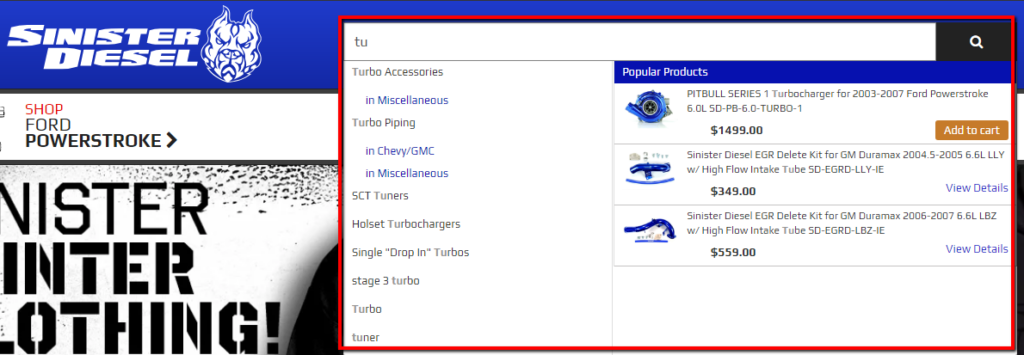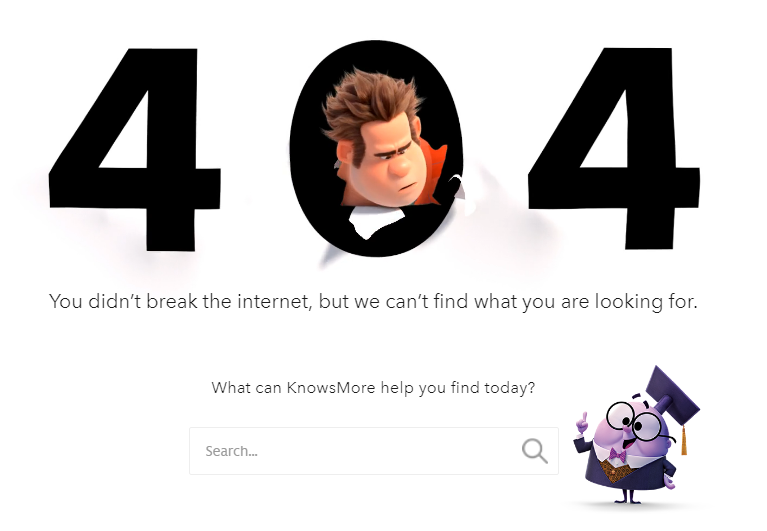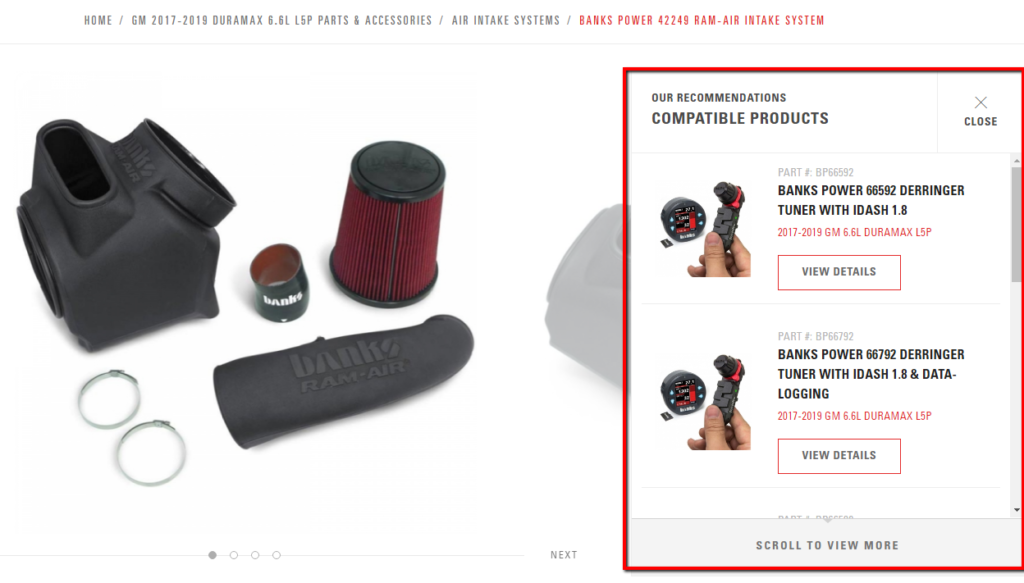The automotive industry is getting more competitive.
Both manufacturers and retailers are realizing the massive opportunity to reach it’s customers where they spend most of their time — online.
Did you know?
84% use Google Search, 90% use sites on the Google Display Network, and 79% are on Facebook? That’s a whole lot of reach!
Auto parts and accessory retailers are perfectly positioned to boost sales from online channels — whether it’s Google, Facebook, Instagram or LinkedIn.
9 Elements Every Best-In-Class Aftermarket Automotive eCommerce Site Must Have
1. Internal Site Search
Google’s homepage is a search bar. It works. Because, by nature, shoppers default to searching.
Letting your customers tell you what they are looking for is a huge opportunity to collect data to improve their experience, your merchandising, and product development.
Here’s a list of features that can enhance your site search:
- auto suggest results
- misspelling handling
- customize number of results returned
- extend search by SKU, make and model, part number, description
- save previous searches
- access custom product fields
Don’t make your website visitors search for the search box! That’s an eCommerce cardinal sin.
Make your search box visible. Don’t be afraid to go BIG. Your site search must be clear. No exception.
CarParts.com and BanksPower.com (full disclosure, our client) are examples of a clear site search boxes. While it sounds like common sense, I’ve seen eCommerce sites that neglect to have clear site search.

Additionally, having placeholders like “Part #” or “Keywords” can assist your customers by letting them know what can be searched for.

Auto suggestions is very helpful to immediately surface popular searches, or top categories to your customer.
SinisterDiesel.com has a really solid auto suggest feature. It returns a buffet of goodness. From top categories, subcategories, popular searches, and products.

Additionally, it deep links and allows you to add to cart.
Last but not least, make sure your eCommerce site search is tracking search terms in analytics.
I cannot stress the importance of recording search query entered. Arming your team with this insight can drastically change the way you merchandise your site.
2. Visually Compelling Homepage
This is a your first impression.
Impress your website visitors or you’ll lose them to another site.
“But Derek, we should not judge the book by its cover.”
Yes my friends.
But your homepage is NOT THE COVER! We’re not talking about a non-fictional novel here. That cliche doesn’t work. Sorry, not sorry.
Rather, your eCommerce homepage sets the expectation for things to come.
Use high quality and high resolution creative assets to showcase your products. Build trust with your customers with a polished homepage.
The homepage is also the page for personalization optimization.
This applies to return visitors. Once you know what they are looking for, you can curate the homepage to their browsing behavior.
3. Year, Make and Model Filters
If there’s one thing I learned from doing marketing in the aftermarket automotive industry, is that car owners are a loyal bunch.
Your eCommerce visitors are likely to own a specific vehicle they are shopping for.
Unlike other industries like fashion or electronics, aftermarket auto parts is unique due to car ownership.
For aftermarket eCommerce sites, a data system like Aftermarket Catalog Exchange Standard (ACES) is helpful to get automotive data from suppliers.
Having a adequate selection of parts for each make and model is going to go a long way for you and your customers.
You don’t need to have a largest selection in the world, but you do need to have the best selection.
4. Marketing Content, And More Content
Content will be king, for a very long time.
Don’t underestimate the long-term value of videos, articles, images, and even podcasts can bring to your aftermarket automotive eCommerce business.
Let’s talk about video for a minute. Video content adds a ton of value for your eCommerce site visitors.
- tutorial videos
- step-by-step installation instructions
- demonstration videos
- product showcase videos
- new product releases
- Q&A videos
- vehicle in-motion videos
In addition to engaging your site visitors with videos, it can also help with your brand’s ranking in Google search results.
Search for the “L5P Duramax” in Google and Banks Power YouTube videos are ranked above everything.

Of course, other content formats like articles, blog posts, and images are great additions as well.
Incorporating your content into eCommerce can reach more people, educate and engage, and ultimate drive the sale. Everyone wins!
5. Promotions and Offers
Everyone loves a deal, or two.
A word of caution. Do not train your eCommerce customers to wait for a promotion, offer, or discounts.
You will devalue your brand.
However, strategic promotions is a tactic that can increase customer loyalty, drive higher order size, and clear out stagnant inventory.
Operating a world-class eCommerce store is not always about the best technology or software.
Sometimes, it means being in-tune with your customers and know when to reward your customers with money-saving opportunities.
Free Shipping
Customers expect free shipping these days. It’s no a premium, but a standard practice for eCommerce businesses.
You can consider different free shipping models based on thresholds, quantity, or only on holidays. Consequently, you can offer free shipping with no minimums.
Free shipping is a great tactic to reduce checkout abandonment. Regardless, don’t spend another minute wondering if you should offer free shipping or not. Your customer expect it. Period.
Spend $X Save $Y
This promotion is popular during holiday sales.
“Spend $200, Save $40,” or “Spend $100, Get $10” are examples of how this offer is promoted.
The objective is to drive the sale across thresholds.
Therefore, if the customer has $180 in their cart, this offer will encourage them to add another item or two.
Category Sale
Retailers offer this promotion to drive categorical revenue — usually running the sale for a limited time.
This is especially effective when retailers need to make room for new inventory. Or to drive interest in slower season.
Categorical sale also gives a chance to acquire new customers who couldn’t afford the full retail price, but have been known about your eCommerce brand for a long time.
It opens up opportunity for your business to reach a broader group of truck and car owners without coming across as a discount brand.
Buy One, Get One (BOGO)
BOGO doesn’t work for every aftermarket automotive eCommerce business.
There just no way to offer your customers 50% off a second cold air intake — why would anyone need two! Right?
This promotional tactic works for certain products like apparel or accessories.
I can see the guys at Thoroughbred Diesel offering a buy one and get 50% off a second hoodie.


thoroughbreddiesel women’s hoodie
6. eCommerce Merchandising
Next time you walk into Target, Walmart, Costco, or any retail store, see how they organize their shelves.
It’s not random. Merchandising teams spend a lot of time putting together a floor plan or layout that will get shoppers to buy more in store.
The same thing applies for your eCommerce store.
Since it’s not a brick-and-mortar, it is even more important to make your products visibly appealing to your customers.
Related products
A great eCommerce site adds value to its customer’s shopping experience.
Related products is an excellent merchandising tactic that can put more relevant products in front of your customers.
For example, customers browsing the Banks Ram-Air Intake System will also see other complementary products.

Ram-Air Cold-Air Intake System, Oiled Filter for use with 2015-16 Ford F-150, 2.7/3.5L EcoBoost
As a result, the related products below are tuners and programmers the eCommerce catalog is suggesting that the truck owner considers buying.

Upsell products
eCommerce businesses have been upselling for a very long time. It’s a tried and true tactic.
It’s not a new concept for both offline and online.
Upselling can increase your checkout order value. Of course, it has to be additional products that your customers want.
Pro tip: make it easy for your customer to add your upsells to their cart. Use one-click add or inline add to cart to reduce the friction.
The last thing you want to do is take your customer away from their checkout funnel.
Other useful ways to leverage upsell is to test new products, clear excess inventory, recommend compatible products, promote relevant top sellers, and more.
Traditional upsell happens in the checkout process.
However, since the customer journey is not linear, eCommerce systems must have the capability to trigger and inject upsells based on desired actions and behavior.
Recommendations
Recommended products are different than top or most popular products.
A recommendation doesn’t necessarily mean it’s a best seller.
However, it’s the most relevant product based on the unique behavior of your customers.
Recommended products are frequently determined by:
- previously or recently viewed items
- items added to cart
- purchase history
- categories visited
Amazon is best-in-class in displaying suggested products to customers.
If you have shopped on Amazon (who hasn’t!), you have probably noticed their “Frequently bought together” or “Customers Who Bought This Item Also Bought” section.
You may have also seen sections like ‘Customers also viewed.’
Recommendations plays a big part in merchandising your eCommerce site.
To be best-in-class, work with your data team to make sure your product data is detailed and always up-to-date.
Bundles and Kits
Bundling takes the guess work away from your customers.
World-class eCommerce sites do the heavy lifting for its customers — through programmatic or manual curation.
Taking a page from Amazon’s bundling tactic — the “Frequently bought together” section helps customers know what other products they need.

And from my personal Amazon shopping experience, the bundling recommendations quite on point.
7. Error Page Handling
No eCommerce site is immune from those dreaded 404 error pages.
The larger your site, the more likely it is to have error pages.
So what do you do?
- don’t let it be a dead end
- have fun with 404 error pages
- guide your customers back home
- keep your search box visible
- simplify your error page
- incorporate your branding
Check out these no-frills 404 error page examples from Amazon.com and Disney.com.


8. Customer Account
A best-in-class eCommerce site doesn’t stop at the shopping experience.
Customer’s post-purchase experience is equally, if not more important for a friction-less affair.
eCommerce is not just about making the sale. It includes everything else that comes after the payment is collected.
Features that make your customer accounts best-in-class:
- order status and delivery tracking
- wish lists creation
- order history
- “My Garage” is a great feature for automotive eCommerce to store vehicle information
- showing relevant products when logged in
- re-order and quick orders for frequently used accessories and parts
- easy return and exchange process
- allowing multiple payment types / split payments
- display exclusive deals and promotions
- easy access to customer service
- robust help section
Customers are the key to your eCommerce success.
A delightful experience from visit to purchase to service will build trust and loyalty. And this leads to growth.
9. Personalization
Saving the best for last.
eCommerce shopping is no longer a mass-approach business.
The focus of technology and innovation in eCommerce is shifting fiercely towards putting your customer data at the center of everything.
Best-in-class means running a people-based eCommerce business. Understanding who you customers are allows for precision targeting at scale.
Your data is the key to unlock your new capabilities to market to people on the other side of the screen, whether it’s search or social.
Personalizing customer experience includes, but not limited to:
- curated homepage on subsequent visits
- customize recommendations based on navigation or purchase
- connecting the dots between offline and online data points
- exclusive offers based on vehicle data
- dynamic discounts based on purchase history
Pro tip: Since not all customers are created equal, incorporating lifetime value (LTV) into your customer-based strategy will help you effectively target the right customers.
Wrapping it up
Incorporating these key eCommerce elements into your online aftermarket automotive store could take your online business to the next level.
It can exponentially increase revenue for years to come.
Measure everything, build your strategy, and be nimble enough to respond to your customers ever-
Get started today.





